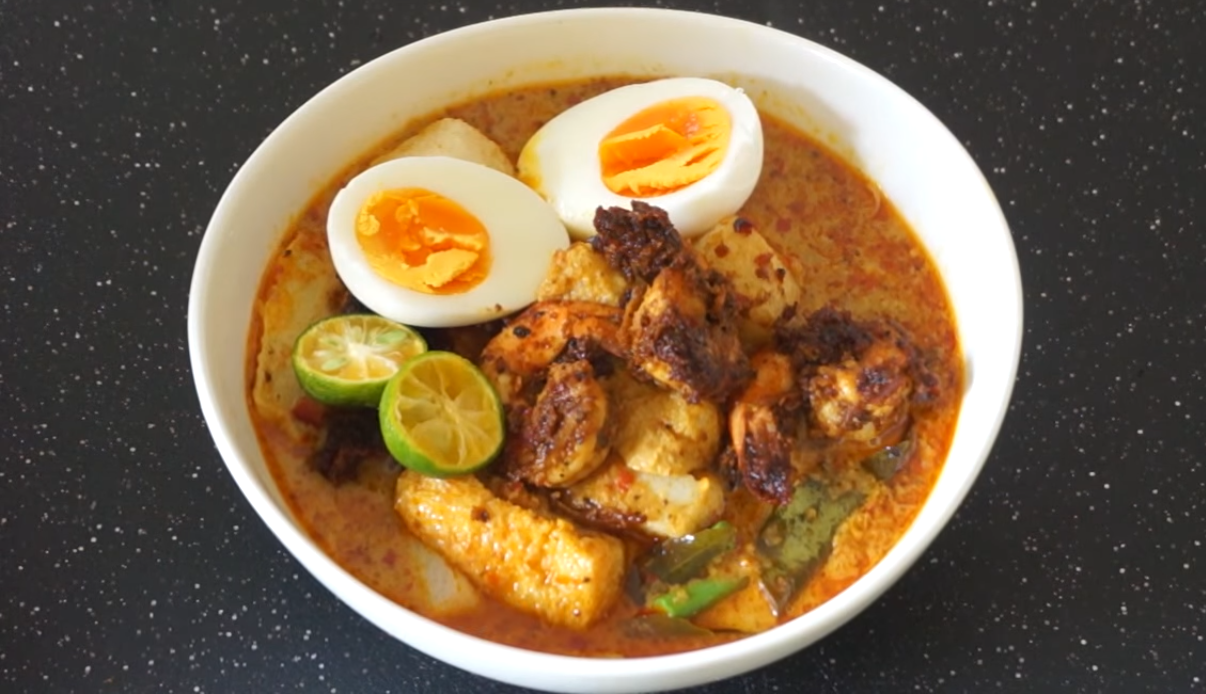This is part of an editorial series where we bring you video tutorials and recipes on how to cook Southeast Asian meals at home
The laksa is one of Malaysia’s most complex – and most delicious – dishes. The most common are, of course, Penang’s asam laksa (sometimes spelled assam laksa) and the curry laksa. Both dishes share a name, but are very different in flavour profiles and texture. Apart from those two, we also have Nyonya laksa, Sarawak Laksa, Johor Laksa and Laksam.
Let’s take a closer look – and let’s learn how to make them so you can impress your guests at your next party:
1. Penang asam laksa
The asam laksa, as its name suggests (‘asam’ is BM for ‘sour’), has a sour and spicy fish based broth. It’s served with thick rice noodles and several condiments like sliced cucumbers, onions, chillies, and lime. This version of laksa is one of the most popular dishes in the country. Here’s a recipe from Flavours of Asia on Youtube:
2. Curry laksa
Found all around the country, curry laksa is also known as curry mee. It’s served with either vermicelli or yellow noodles – or a combination of both – in a curry-like broth packed with tofu, chicken and bean sprouts. Some stalls even offer the option of adding in cockles. Flavours of Asia comes through again with another simple laksa recipe:
3. Nyonya laksa
Similar to the curry laksa in that it is coconut based, the Nyonya laksa broth is made with both chicken bones and prawn shells. This variant, also known as laksa lemak (fatty laksa), is a popular dish in Melaka. It is rich, spicy, sweet, and entirely satisfying to eat. Nyonya Cooking has a recipe you can follow – it can be a little tedious but trust me, it’s worth every effort:
4. Sarawak laksa
The Sarawak laksa broth is made with sambal belacan (chili paste / sauce with fermented shrimp) – many people just use store-bought Sarawak laksa paste since it can be tedious to make from scratch. That said, this variation of laksa can be difficult to find in West Malaysia, but you can buy the paste from sambalsatu.com if you plan on cooking this up.
Any restaurants in KL that serve Sarawak Laksa will definitely have adapted the recipe from the Bornean original, which includes coconut milk, tamarind, omelette strips, chicken, prawns, and lime. Modified versions may include tofu and bean sprouts. Here’s a recipe you can follow from Huang Kitchen on Youtube:
5. Johor laksa
These next two dishes are quite different the first four in terms of flavour and appearance. Johor laksa is made with spaghetti instead of the traditional rice noodles or egg noodles. Also, the noodles are served with a thick sauce instead of a broth. The sauce is made of fish, dried prawns, lemon grass, and spices.
To make this Malaysian heritage food (as declared by the Malaysian Heritage Department), just follow this recipe by iCookAsia:
6. Laksam
Laksam is sometime referred to as a variant of the laksa commonly found in Terengganu and Kelantan. The difference is that laksam is served with thicker and flatter rice noodles. The broth for laksam is lightly coloured and is made with mackerel and has coconut milk, tamarind, lemongrass, shallots and the usual fragrant ingredients, including slices of dried asam.
The dish is served with raw vegetables and some sambal on the side. iCookAsia has a full recipe you can follow including how to make the noodles:
7. You tell us! What is your hometown laksa like?
In addition to the above, there are almost countless regional variations – and we’re only talking about inside Malaysia! For example, variants of asam laksa include Perlis laksa or Kedah laksa, which are similar to Penang Laksa but use catfish and eel, or extra eggs, respectively; Kedah laksa, which uses rice noodles; and Kuala Kangsar Laksa, made with wheat flour.
For variants on the curry laksa, Kelantan laksa is made using predominantly mackerel and coconut cream, while Terengganu laksa uses boiled round scad mackerel which are fried with datil pepper, kantan flowers and Vietnamese coriander.
We’re sure there are plenty more other than what we’ve listed here, so the only thing that’s left is for you to tell us your favourite!
"ExpatGo welcomes and encourages comments, input, and divergent opinions. However, we kindly request that you use suitable language in your comments, and refrain from any sort of personal attack, hate speech, or disparaging rhetoric. Comments not in line with this are subject to removal from the site. "



















